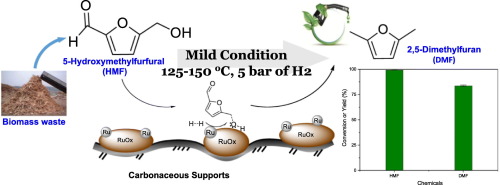当前位置:
X-MOL 学术
›
Fuel Process. Technol.
›
论文详情
Our official English website, www.x-mol.net, welcomes your
feedback! (Note: you will need to create a separate account there.)
Understanding catalytic hydrogenolysis of 5-hydroxymethylfurfural (HMF) to 2,5-dimethylfuran (DMF) using carbon supported Ru catalysts
Fuel Processing Technology ( IF 7.2 ) Pub Date : 2020-03-01 , DOI: 10.1016/j.fuproc.2019.106225 Tai-Wei Tzeng , Chan-Yi Lin , Chih-Wen Pao , Jeng-Lung Chen , Rob Jeremiah G. Nuguid , Po-Wen Chung
Fuel Processing Technology ( IF 7.2 ) Pub Date : 2020-03-01 , DOI: 10.1016/j.fuproc.2019.106225 Tai-Wei Tzeng , Chan-Yi Lin , Chih-Wen Pao , Jeng-Lung Chen , Rob Jeremiah G. Nuguid , Po-Wen Chung

|
Abstract Herein, our study has demonstrated that microporous carbon supported Ru catalysts can selectively convert 5-hydroxymethylfurfural (HMF) to 2,5-dimethylfuran (DMF) in isopropanol through hydrogenolysis in a catalytic ratio of 2.47mol% under 5 bar of hydrogen at 125 °C for 1 h. DMF yield can reach 69.52% with complete HMF conversion. The effects of reaction temperature, hydrogen pressure, metal loading and reaction solvent for hydrogenolysis have been carefully investigated. In addition, to better understand the influence of the intrinsic nature of carbonaceous material, carbon materials possessing different surface texture including microporosity, mesoporosity and nonporous carbon black were used as catalyst supports, and structural properties have been comprehensively characterized by powder X-ray diffraction spectrometer (PXRD), transmission electron microscopy (TEM), nitrogen and CO2 sorption, thermogravimetric analysis (TGA), and X-ray absorption spectroscopy (XAS). We have concluded that the nature of the carbonaceous material affects the Ru nanoparticle formation upon thermal reduction. The atomic configuration of Ru nanoparticles on carbon support (i.e., metallic Ru or RuOx) would direct the catalytic pathway differently and could be attributed to the interaction between ruthenium and carbon surface.
中文翻译:

了解使用碳负载 Ru 催化剂将 5-羟甲基糠醛 (HMF) 催化氢解为 2,5-二甲基呋喃 (DMF)
摘要 在此,我们的研究表明,微孔碳负载 Ru 催化剂可以在异丙醇中通过氢解将 5-羟甲基糠醛 (HMF) 选择性地转化为 2,5-二甲基呋喃 (DMF),在 5 bar 的氢气和 125 ℃ 1 小时。在 HMF 完全转化的情况下,DMF 产率可达 69.52%。已经仔细研究了反应温度、氢气压力、金属负载量和反应溶剂对氢解的影响。此外,为了更好地理解碳质材料内在性质的影响,采用具有微孔、介孔和无孔炭黑等不同表面纹理的碳材料作为催化剂载体,并通过粉末X射线衍射仪对结构特性进行了综合表征。 (PXRD), 透射电子显微镜 (TEM)、氮和 CO2 吸附、热重分析 (TGA) 和 X 射线吸收光谱 (XAS)。我们已经得出结论,碳质材料的性质会影响热还原时 Ru 纳米颗粒的形成。Ru纳米颗粒在碳载体(即金属Ru或RuOx)上的原子构型会以不同的方式指导催化途径,这可能归因于钌和碳表面之间的相互作用。
更新日期:2020-03-01
中文翻译:

了解使用碳负载 Ru 催化剂将 5-羟甲基糠醛 (HMF) 催化氢解为 2,5-二甲基呋喃 (DMF)
摘要 在此,我们的研究表明,微孔碳负载 Ru 催化剂可以在异丙醇中通过氢解将 5-羟甲基糠醛 (HMF) 选择性地转化为 2,5-二甲基呋喃 (DMF),在 5 bar 的氢气和 125 ℃ 1 小时。在 HMF 完全转化的情况下,DMF 产率可达 69.52%。已经仔细研究了反应温度、氢气压力、金属负载量和反应溶剂对氢解的影响。此外,为了更好地理解碳质材料内在性质的影响,采用具有微孔、介孔和无孔炭黑等不同表面纹理的碳材料作为催化剂载体,并通过粉末X射线衍射仪对结构特性进行了综合表征。 (PXRD), 透射电子显微镜 (TEM)、氮和 CO2 吸附、热重分析 (TGA) 和 X 射线吸收光谱 (XAS)。我们已经得出结论,碳质材料的性质会影响热还原时 Ru 纳米颗粒的形成。Ru纳米颗粒在碳载体(即金属Ru或RuOx)上的原子构型会以不同的方式指导催化途径,这可能归因于钌和碳表面之间的相互作用。











































 京公网安备 11010802027423号
京公网安备 11010802027423号